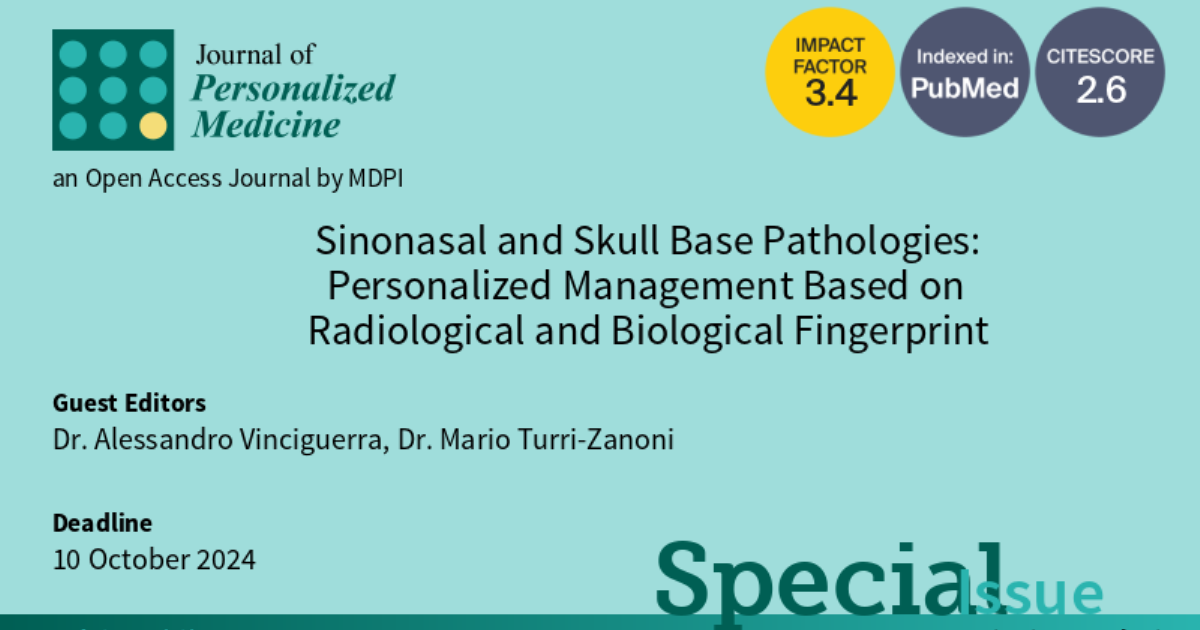Sinonasal and Skull Base Pathologies: Personalized Management Based on Radiological and Biological Fingerprint
A special issue of Journal of Personalized Medicine (ISSN 2075-4426). This special issue belongs to the section "Personalized Therapy and Drug Delivery".
Deadline for manuscript submissions: 10 October 2024 | Viewed by 3104

Special Issue Editors
Interests: head and neck surgery; endonasal endoscopic surgery; skull base surgery; rhinology; sinonasal cancer; skull base tumors
Interests: head and neck surgery; endonasal endoscopic surgery; skull base surgery; rhinology; sinonasal cancer; skull base tumors
Special Issue Information
Dear Colleagues,
It is our great pleasure to invite you to contribute to this Special Issue of the Journal of Personalized Medicine.
In the past few decades, our understanding of sinonasal pathologies and skull base lesions has improved. As a result, many inflammatory sinonasal lesions involving the skull base may now be effectively treated endoscopically, and several benign and malignant tumors can be approached using different personalized surgical techniques. Nevertheless, several limits are still present and, for some rare histologies, the correct management is still open to debate.
In this Special Issue, we aim to highlight the most recent advancements in this field, focusing our attention on the personalized management of different sinonasal and skull base pathologies.
Dr. Alessandro Vinciguerra
Dr. Mario Turri-Zanoni
Guest Editors
Manuscript Submission Information
Manuscripts should be submitted online at www.mdpi.com by registering and logging in to this website. Once you are registered, click here to go to the submission form. Manuscripts can be submitted until the deadline. All submissions that pass pre-check are peer-reviewed. Accepted papers will be published continuously in the journal (as soon as accepted) and will be listed together on the special issue website. Research articles, review articles as well as short communications are invited. For planned papers, a title and short abstract (about 100 words) can be sent to the Editorial Office for announcement on this website.
Submitted manuscripts should not have been published previously, nor be under consideration for publication elsewhere (except conference proceedings papers). All manuscripts are thoroughly refereed through a single-blind peer-review process. A guide for authors and other relevant information for submission of manuscripts is available on the Instructions for Authors page. Journal of Personalized Medicine is an international peer-reviewed open access monthly journal published by MDPI.
Please visit the Instructions for Authors page before submitting a manuscript. The Article Processing Charge (APC) for publication in this open access journal is 2600 CHF (Swiss Francs). Submitted papers should be well formatted and use good English. Authors may use MDPI's English editing service prior to publication or during author revisions.
Keywords
- sinonasal tumors
- skull base tumors
- rhinology
- multidisciplinary cancer treatment
- endoscopic surgery
- transnasal approach
- target therapy
- inflammatory sinonasal pathologies
- chronic rhinosinusitis
- nasal polyps







